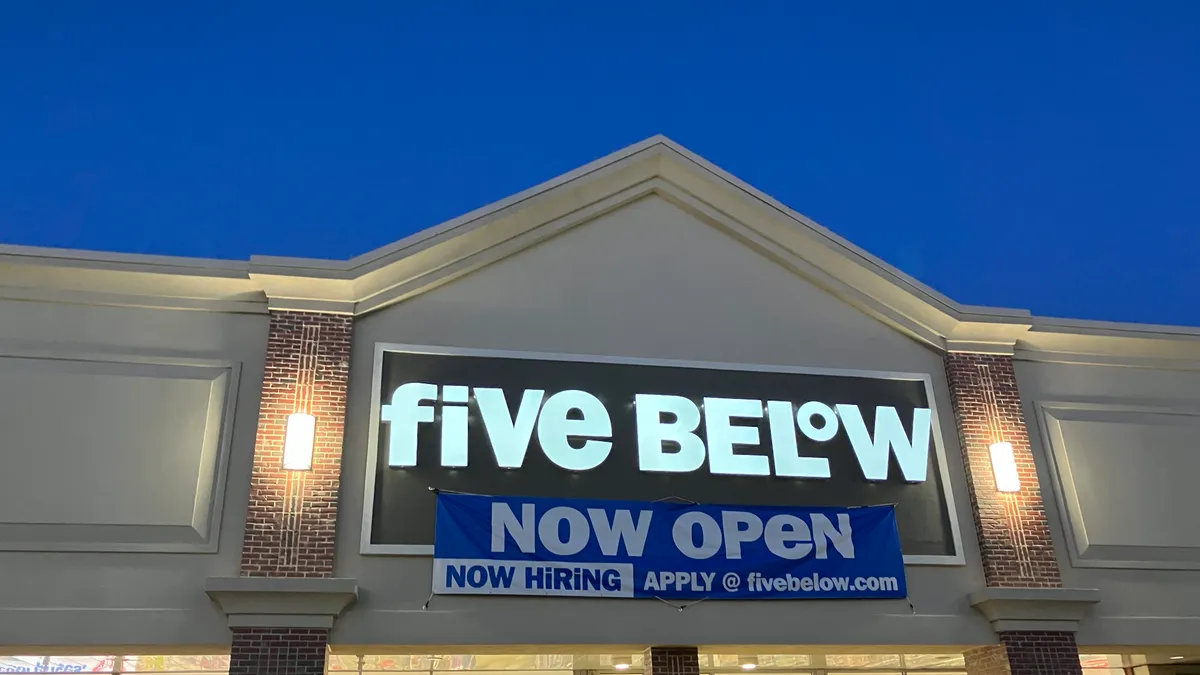Dive Brief:
- After fighting against high shrink for more than a year, Five Below has transitioned to 75% associate-led transactions at all stores and 100% associate-led transactions at high shrink stores, company executives said during an earnings call last week.
- Five Below said in March it would scale back self-checkout to fight shrink. It also said it tested additional shrink reduction strategies in about 70 stores during Q1. They include receipt checks by associates, more video cameras, and adding guards. Stores with associate-led checkout and other mitigation measures saw lower shrink rates, CEO Joel Anderson said.
- The news comes as Five Below reported that while its net sales rose 11.8% year over year to $811.9 million in Q1, comp sales fell by 2.3% from a year ago. Net income also declined in the quarter, dropping 16% to $31.5 million from $37.5 million a year ago.
Dive Insight:
Five Below is joining a growing wave of retailers — Walmart, Target and Dollar General among them — that are limiting self-checkout services or removing it altogether to reduce customer-related shrink and theft.
“While we are implementing changes to address recent sales trends and offset shrink, we remain committed to our strategic pillars and continue to see a long runway of growth for Five Below,” said Anderson. An element of the company’s growth strategy includes significant opportunities to add store density in existing markets and opening in new markets.
Additionally, Anderson said performance fell short of the company’s expectations due in part to a sales slowdown in the back half of Q1. Five Below lowered its full year guidance and expects net sales to range from $3.79 billion to $3.87 billion, down from $3.97 billion to $4.07 billion. The company now anticipates a 3% to 5% decrease in comparable sales, with net income ranging from $275 million to $297 million.
During Q1, consumers at the tween and teen-focused retailer chose more items in Five Below’s consumables category, which includes candy, food and beverages and beauty. “The quarter solidified that consumers are feeling the impact of multiple years of inflation across many key categories, such as food, fuel, and rent, and are therefore far more deliberate with their discretionary dollars,” Anderson said.
And in contrast with off-price retailers, apparel, which slots more in the non-discretionary category, represents a much smaller percentage of Five Below’s business, Anderson said.
Jefferies analysts led by Randal Konik said in a note that Q1’s top and bottom line results were below expectations, adding that “shrink is a problem, and it’s continuing. Results are being pressured and so is the outlook.”
Although the company achieved positive comps in higher income cohorts — which indicates trade down by people seeking value — those results were offset by under performance amongst lower income consumers, Anderson said according to a call transcript.
“In the end, management could not thread the needle of lowering the bar without fueling broader concerns about the story,” Wells Fargo analysts led by Edward Kelly said in a note. “[Five Below] looks to be in [a] bad spot from a macro standpoint (discretionary heavy with plenty of low-end exposure), but it's still surprising the business has slowed this much with more mixed results elsewhere.”
Five Below opened 61 new stores during the first quarter, operating a total of 1,605 stores in 43 states as of May 4. The company said that’s a 17.4% year over year increase in store count. Five Below plans to open 230 stores by end of year and Anderson said the company still sees “a long runway of growth” reiterating previous statements that it wants to operate 3,500 locations nationwide by the end of 2030.
Meanwhile, the retailer is continuing to grow its Five Beyond offering, which features products that exceed the company’s namesake price point. Anderson said the Five Beyond format continues to generate a positive customer reaction and it also performs the best in lower household income stores.
Despite shrink and inflationary pressures, Konik said Five Below benefits from a differentiated store and business model, adding that the company’s long-term store count growth goal is not only achievable but perhaps even conservative. “The inclusion of higher-price-point products in its assortment should enhance [Five Below’s] value offering and yield many benefits,” Konik said.













